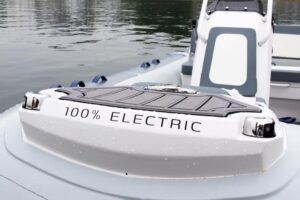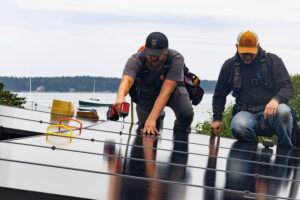As the home one of the world’s richest marine ecosystems, the Gulf of Maine is the foundation for a large sector of Maine’s economy and a resource for innovation as we look to the years ahead. By investing in clean marine energy solutions, we are helping forward-looking marine businesses innovate and thrive, while propelling the state closer to achieving its Climate Action Plan.
Electrifying Maine’s Working Waterfront
 Boats, like cars, have a carbon footprint. By investing in and supporting electric outboard technology, we are helping marine businesses compete, while also reducing greenhouse gas emissions. Explore our Electric Boat Toolkit page, designed to guide marine businesses and municipalities through the transition to electric propulsion.
Boats, like cars, have a carbon footprint. By investing in and supporting electric outboard technology, we are helping marine businesses compete, while also reducing greenhouse gas emissions. Explore our Electric Boat Toolkit page, designed to guide marine businesses and municipalities through the transition to electric propulsion.
The first step in transitioning Maine’s marine fleet from fossil fuel to electric motors is putting the proven technology in the hands of those who will rely on it. By deploying demonstration boats in harbors, building out the supporting shoreside infrastructure for expansion, and raising Maine’s profile as a leader in electric propulsion, we are accelerating the adoption of climate-friendly technology and protecting our waters. Island Institute is also creating educational opportunities to accelerate adoption. In partnership with with Kennebec Valley Community College, Mid-Coast School of Technology, Maine Electric Boat Company, and Bayside Marine, Island institute is pleased to offer the Electric Boat Course.
 In addition to marine motor electrification, Island Institute works to support Maine’s working waterfront businesses to implement solar arrays, energy efficient systems, and other practices that offer a “triple bottom line” of environmental, economic, and social sustainability. From boat yards to lobster co-ops and emerging aquaculture businesses, Island Institute is helping Maine’s working waterfront create a climate-forward marine economy.
In addition to marine motor electrification, Island Institute works to support Maine’s working waterfront businesses to implement solar arrays, energy efficient systems, and other practices that offer a “triple bottom line” of environmental, economic, and social sustainability. From boat yards to lobster co-ops and emerging aquaculture businesses, Island Institute is helping Maine’s working waterfront create a climate-forward marine economy.
One important aspect of our work in this area is providing Spark! Grants for working waterfront energy projects that improve energy efficiency, focus on renewable energy, and reduce consumption of fossil fuels.
To learn more about our work in this area, review our electric boat demonstration pager.
Greenhouse Gas Emissions Assessments
In 2022 Luke’s Lobster and Island Institute commissioned a first-of-its-kind evaluation of a seafood company’s carbon footprint, and we’re continuing our work to help Luke’s and other seafood companies to lower their carbon emissions. Island Institute periodically commissions similar studies for shellfish aquaculture carbon footprint evaluations to inform a greener seafood industry in Maine and beyond.
A Climate of Change: Clean Energy Solutions for the Working Waterfront
The sixth film in our ongoing climate-related documentary series, A Climate of Change: Clean Energy Solutions for the Working Waterfront, follows Sam Belknap of Island Institute as he travels the Maine coast to meet with innovators on the working waterfront. Watch the short film to learn more about how Island Institute connects marine entrepreneurs with resources and support as they pursue solar arrays, electric boats, and efficient cooling systems.

